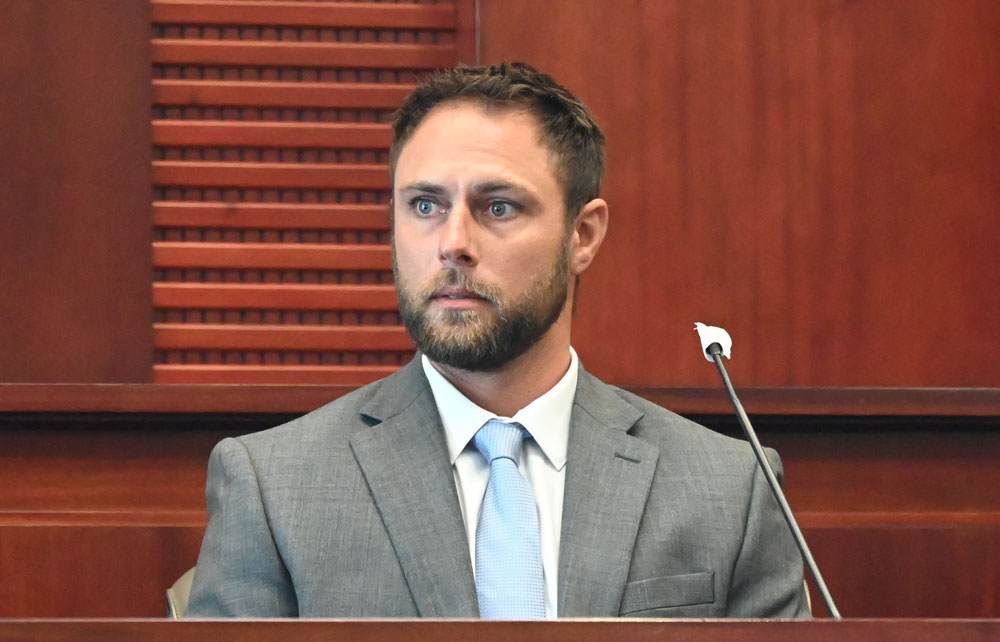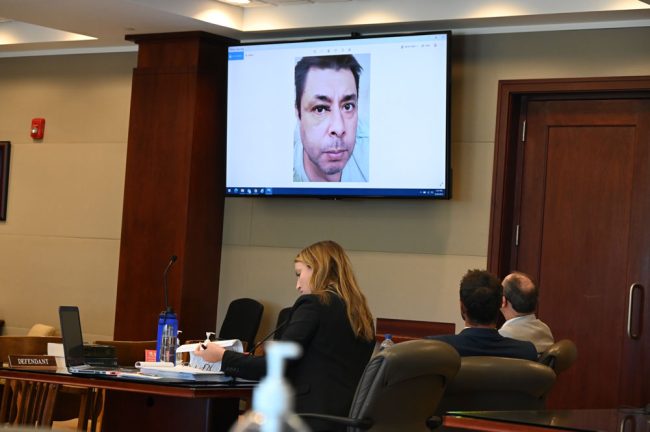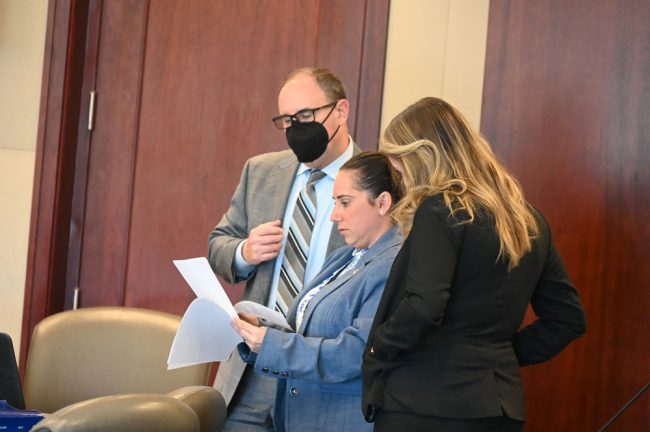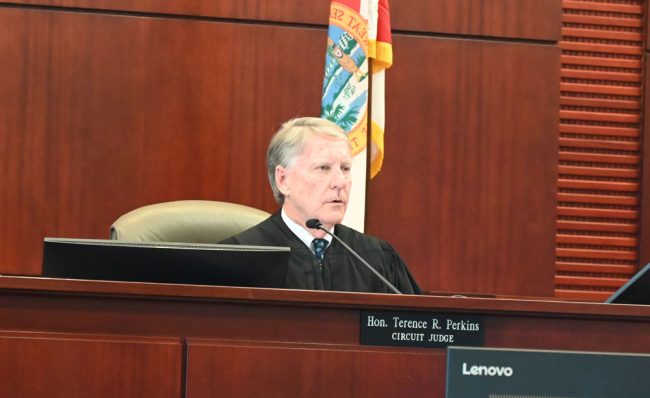
See coverage of the Travis Smith trial on Day One and Day Two.
Travis Schriever Smith, the 38-year-old Palm Coast resident who assaulted a Lyft driver in an unprovoked and drunken attack in the early days of the pandemic, was found guilty of battery, a misdemeanor, but acquitted of a felony burglary charge by a jury of four women and two men at the end of a three-day trial in Circuit Court in Bunnell this evening.
Smith kept the same demeanor he had all three days, whether sitting back in his chair or standing at attention: he stared in front of him, unflinchingly, unemotionally. His attorneys Mary Catherine Crock and Philip Bonamo, were more visibly expressive, and Bonamo had a mask on. The jury had deliberated two hours and 40 minutes, announcing it had a verdict at 7:20 p.m.
Smith faces only a jail term of up to a year when he is sentenced. He had faced up to 16 years had he been found guilty of the burglary charge.
Circuit Judge Terence Perkins felt no magnanimity toward Smith: he ordered his bond revoked and Smith sent to the county jail pending sentencing, denying his attorney’s attempt to keep him out of jail. In 2007, Smith was sentenced to 30 days in jail and two years on probation after being found guilty of drunk driving when he was living in Bel Air, Maryland.
The case hinged on an 12-minute Lyft ride the night of August 1, 2020, from the 7-Eleven in Flagler Beach to what was supposed to be a destination in Palm Coast’s R-Section. The ride never made it there. Smith attacked the driver, 49-year-old Nihat Aksezer, a W-Section resident, at the intersection of Royal Palms Parkway and Belle Terre Parkway, by ripping down a divider between the front and back seat, grabbing his head in a headlock.
The burglary charge was based on Smith breaking the divider and entering a space from which he’d been barred. But the jury didn’t buy that it was burglary, thus sparing Smith of the more serious second-degree felony charge. (Juries are not made aware of the difference in charges, or even told whether they are felonies or misdemeanors.)
The split verdict means that Smith committed a violent crime, but not one so grave as to warrant prison time.

Aksezer, an American citizen of Turkish descent, has a heavy Middle Eastern accent and speaks at times broken English. He says the attack was unprovoked. But it was not out of that night’s character. Just before the ride started, when Smith spoke with Aksezer on the phone, Smith had insulted him and profaned Aksezer’s wife. Aksezer doesn’t know why. Aksezer considered not taking the fare, sensing something amiss in Smith’s behavior. But Smith was with a friend and a 7-year-old child, it was late, Aksezer (a parent himself) didn’t want them stranded. So he took the fare.
It was uneventful for most of the way. Then Smith, speaking the slurred speech of a drunk, started asking Aksezer about the filmy partition Aksezer had installed between front and back seats as a Covid-safety measure. (Aksezer was masked, his riders were not.) Aksezer explained he’d installed the partition himself. After Smith mumbles something incoherent or nonsensical about three people he knew, he inexplicably calls Aksezer a liar.
Aksezer is startled, but keeps his cool, drives on. He’d handled drunken drivers before down to having to clean up their puke, he’d testified. Then a light comes on in the car. Smith’s friend, Andrew Kastl, had unlatched his door. Soon after that, Smith attacks Aksezer, ripping the partition dividing front and back seats, Kastl yells to Smith to “get that motherfucker,” jumps out, yells at his son to jump out, and Smith jumps out the back window, only to moments later pummel Aksezer in a median before cops arrive and arrest Smith.
After reviewing video, deputies deemed Smith’s account–that he and his friend had become fearful of Aksezer’s driving–dishonest. The jury did likewise today, up to a point.
Smith had lied to cops. But it was nothing compared to his testimony in court today.

Under oath or not, people lie on the stand. That’s not unusual. It’s why there are trials. But Smith’s performance today was a stunning display of brazen, defiant fabrications, with an assist from a zoomed-in Kastl and stage direction from his attorneys.
Smith claimed he attacked the driver to save himself, his best friend Kastl, and Kastl’s 7-year-old child from Aksezer, because, as Smith told sheriff’s deputies at the time and his defense repeated at trial, Aksezer had been driving erratically, blowing through red lights, and putting the trio in danger.
But dash cam video footage that captured the entirety of the ride within the car and almost all of its route, seeing out, made Smith out to be a liar. This isn’t a case of gray areas, as the defense would contend: the videos are not grainy, the sound isn’t muffled, the angles not in question. Most essentially, the defense never questioned the video’s authenticity. Like Smith, it acted as if the videos did not exist, as if it could convince the jury to pretend that what they saw and heard wasn’t what they saw and heard.
Here’s what they saw: Aksezer never runs a light. Not even a yellow. He is not speeding: his Google Maps would have let him know if he did. He was not erratic.
“I believe I saw Mr. Aksezer go through a long yellow or a red, and asked him to pull over, after we went over the bridge, past the Publix,” Smith said on the stand today. “We asked him to pull the car over, he didn’t. I tried to be very stern about it.”
By “we,” Smith meant him and Kastl. But the video shows none of that, nothing but green lights, not a hint of an argument, no sternness, nothing from Kastl, either. At that point as the car was driving past Publix on the State Road 100 straightaway, Smith was joking with the 7-year-old.
“So how many times did you ask Mr. Aksezer here to pull over?” Bonamo asked him.
“I would say I asked one time, politely. The second time it was a little more stern but polite and then I told him the third time, and then we started yelling at each other at that point,” Smith said.
“Did he comply or follow your request?”
“He did not.”
Kastl had said almost identical things in his deposition, echoed again in his zoom testimony today.
“There was a stop sign right there that we had just blown right through. It was a sharp right-hand turn,” Kastl had said, words that might have been lifted from Smith’s account. He said he recalled the driver “blowing through a stoplight.” In his deposition he said: “we yelled out to the guy, you need to stop, let us out right now, we do not want to be in here any longer.”
All lies.
Kastl then accused Aksezer of rudeness: “he turned around and he yelled what I believe was either shut up or be quiet. And at that point — at that point in time, Travis and him were, you know, going back and forth… there was words that were going back and forth.”
All lies.
Kastl’s son testified today by zoom, too. He repeated the same account, as if he’d been coached through his father’s deposition, and though 9 year olds have trouble remembering what happened days or weeks ago, he quoted Aksezer (or his father’s deposition) almost word for word: “Travis asked if we could pull over when the argument happened,” the boy testified.

“Did you hear the driver say think back to your side?” Bonamo asked him.
“He said to shut up and be quiet,” the boy replied.
Kastl and his son zoomed in from Minnesota. Kastl claimed when he got his son out, he started yelling and pointing at cars “to get that mother fucker.” Another lie: he had made that statement to Smith right before jumping out, referring to Aksezer.
In fact, the only exchange of note the whole ride, before Smith started getting belligerent with Aksezer, was when Smith asked him if he could open the window, to which Aksezer said no problem. (Smith claimed it was his friend who asked to open a window.)
Assistant State Attorney Tara Libby–who tried the case with Assistant State Attorney Vanessa Brooks–replayed the entire juxtaposed videos for Smith and asked him, point by point, where at any point there’d been a blown traffic light, where he’d argued witht Aksezer, where he’d asked him to pull over. Smith with every question replied the same four words: “Not in that video.”
He was being tactically clever: he was implying to the jury that there was another video. There isn’t.
At one point, when the jury was sent out so the judge and the lawyers could discuss the point, Smith claimed that he’d paid $11,000 to have the video forensically analyzed. His attorneys said the company would not share the results or get involved in the case, nor send its findings to the prosecution or the defense. It all sounded outlandish even to Circuit Judge Terence Perkins, who did not like that bit of alleged evidence introduced at the last minute, denying the prosecution a chance to prepare.
The prosecution had been aware of the supposed analysis, but the defense had told it previously that none of that would be introduced at trial, so no depositions were set. Perkins justifiably–and obviously–forbade any mention of the whole forensic-analysis story before the jury.
Bonamo never asked Smith about the blatant contradictions between his testimony and the videos repeatedly shown, even after Libby eviscerated Smith’s veracity by having him say those four words– “not in that video–close to a dozen times, essentially showing him to have lied that many times.
Aksezer’s testimony, on the other hand, corroborated what the jury saw in the videos.
“Do you ever remember either Mr. Smith or Mr. Kastle complaining about your driving?” the prosecutor asked him in testimony on Tuesday.
“No, they never complained about my driving,” he said.
“Did they ever tell you they were scared of your driving?”
“No.”
“Did you ever yell at Mr Smith during this Lyft ride?”
“No, never.”
Libby told Smith he testified of asking the driver to let them out. Where, she asked him.
“Near Colbert Lane,” Smith said.
“We didn’t hear that in the video.”
“Not in that video, no,” Smith said.
That lie was notable, because the defense used it to establish a “nexus,” in Bonamo’s description, between the defense’s claim and the prosecution’s own witness testimony–that of Aksezer himself.
On Tuesday, when he was on the stand, Aksezer testified that at one point Smith had asked–not to be let out (as the defense falsely claimed), but to stop and check the vehicle. “He said there was something wrong with the vehicle and I had to check it,” Aksezer testified, but he didn’t stop.
He would soon walk back that statement and insist that he’d not testified to that effect, giving the appearance that he’d misspoken or been confused with his answer: the prosecutor could have elicited clearer answers from him to clean up any issues with his broken English. She did not.
But Aksezer had, in fact, said at one point that he’d been asked to stop–but not on Colbert. Aksezer said that happened on Royal Palms Parkway, as tensions were rising in the car, though none of that is visible or audible on the video, either. Aksezer said he didn’t want to stop on Royal Palms because it’s a dangerous two-lane road, and because “I felt like they were planning something.”
“Were you afraid of being attacked?” the prosecutor asked.
“Yes.” (The defense’s strategy was to hope that the jury would disbelieve everything they saw and heard on video and believe only what the witnesses said on the stand–their witnesses, anyway. While the defense seized on that one statement by Aksezer about being told to stop on Royal Palms as absolutely true, they also dismissed everything else he said on the stand as not believable. It was up to the jury to decipher the untenable gambit.)
Aksezer was clearly rattled as he drove the easternmost part of Royal Palms, slowed the car down considerably, asked the men what was going on, and got no answer clearly audible on the video. Smith, however, accused him of putting on the interior light (and could possibly have mumbled something about pulling over, but that’s not audible). Aksezer resumed normal speed in the 35 mph zone (not the 45 to 50 Smith claimed).
What Bonamo in his closing very effectively did is build a case on a non-existent premise aside from what his client and his friend had said in their testimony: he took as fact and presented to the jury as fact what the video proved were lies. Put another way: it was as if the defense was asking the jury to ignore, say, DNA evidence in a gang rape just because the defendants said their DNA evidence found in the victim shouldn’t be believed, because all the rapists said it shouldn’t be.
The defense paired that approach with a claim of self-defense.
“Under the law, and as you’ll see on the jury instructions, there’s what’s called justifiable use of non-deadly force,” Bonamo told the jury in his closing argument. “That’s the legal fancy term for self defense of yourself or self-defense of others. So what is that? Is that applicable here? And members of the jury, I say yes, based on the evidence, It certainly is.” He continued: “It’s clear based on the evidence and what we see in the inconsistencies of the video with the alleged victim, is that this was a justified situation.”
The prosecution, of course, saw it differently.
“This is not a justifiable use of force,” Libby said in her closing. “This is not somebody who merely was trying to help himself and help others. These are the actions of a drunk man, who for whatever reasons only known to him, decided he just wanted to go ahead and attack his Lyft driver. Ladies and gentlemen, the video. You’ve seen the video. You’ve heard the video. The defendant’s version of events, Mr. Kastle’s version of events, they do not match the video. This is not a misconception.
“This is not a case where there’s justifiable use of non-deadly force. This is not that case. This is completely unjustifiable. Mr. Smith’s actions are unjustifiable. Did the victim say that the defendant said to stop the vehicle? He did say that on direct. But he also stated that he felt that he was being tricked. He was outnumbered by two drunk men in the back of his vehicle. There is no gray area in this. No. The video doesn’t lie.”
The jury may have agreed with Libby, but the defense’s strategy had been effective enough to neutralize the more serious charge, which may have been the defense’s aim all along.
Aksezer still lives in Palm Coast but has given up on Lyft and Uber, for whom he also drove–at least on human cargo. He said he’s lost trust in human beings. He still drives for DoorDash and Uber Eats. Groceries don’t get drunk, don’t puke, don’t insult or raise a hand.
![]()




























Peaches McGee says
Oh, Travis. When you get out of jail you should move far, far away.
Everyone knows your name and face in our little part of Floriduh.
Steve says
Cya No Bond A year to think about being drunk and stupid. Bet you spent alot legally too.
C’mon man!! says
Guys full of shit. He attacked that guy then lied on the stand. His friend then zoomed in and lied as well. Glad the jury saw through that BS
The dude says
Gotta love Flagler County.
A place where two drunk Florida men prevail over a brown man who was simply out working to support his family.
I knew Florida man had a pretty strong chance of walking when I saw he’d be judged by his “peers”. Trash protects trash.
Steve says
Yes yes you did. And, on top of it he lied IMO
A.j says
Found guilty, surprised. Justice system gradually changing. Years ago, certain people would attack darker people and was set free. O I forgot that is still happening.
A.j says
Will he get any punishment? Probably not. The victim a person of color, the attacker white, just put 2 and 2 together, you get where I’m going.
Steve says
You might want to read the Article again